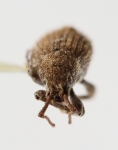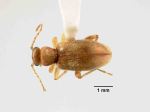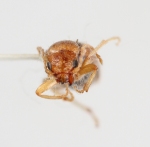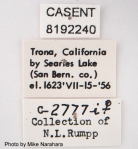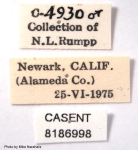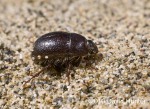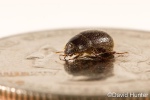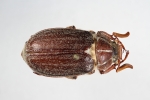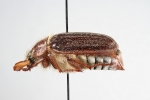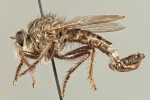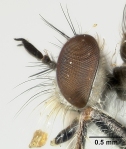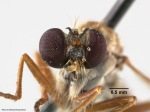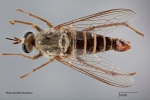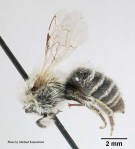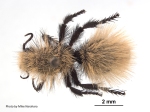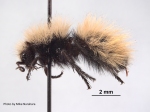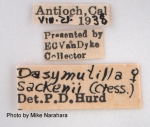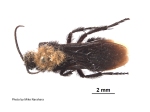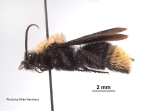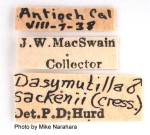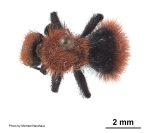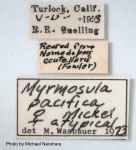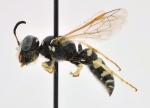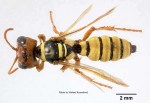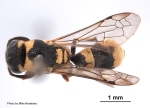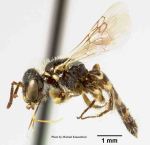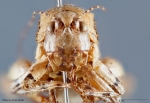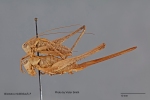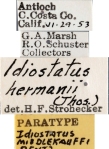Dune Insects
Leave a commentLange’s Metalmark Butterfly see Lange’s metalmark (Apodemia mormo langei)
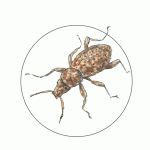 Weevils Also known as snout beetles for their long “noses.” The Antioch weevil (Dysticheus rotundicollis) is endemic to the Antioch Dunes, although it is unknown whether this species is still present today.
Weevils Also known as snout beetles for their long “noses.” The Antioch weevil (Dysticheus rotundicollis) is endemic to the Antioch Dunes, although it is unknown whether this species is still present today.
.
.
- Antioch weevil (Dysticheus rotundicollis)
- Antioch weevil (Dysticheus rotundicollis)
- Antioch weevil (Dysticheus rotundicollis)
- Antioch weevil (Dysticheus rotundicollis)
- Antioch weevil (Dysticheus rotundicollis)
- Antioch weevil (Dysticheus rotundicollis)
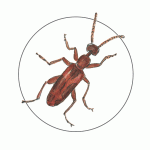 Anthicid Beetles These ant-like flower beetles devour anything they find, scavenging at night for insects and spiders, flower pollen, and soil fungi. The Antioch Dunes anthicid beetle (Anthicus antiochensis) is rusty-colored except for a dark smudge on its wing casings, and is covered with shaggy hairs. It has been extirpated from the Antioch Dunes, but has been found in other California sand dunes.
Anthicid Beetles These ant-like flower beetles devour anything they find, scavenging at night for insects and spiders, flower pollen, and soil fungi. The Antioch Dunes anthicid beetle (Anthicus antiochensis) is rusty-colored except for a dark smudge on its wing casings, and is covered with shaggy hairs. It has been extirpated from the Antioch Dunes, but has been found in other California sand dunes.
- Antioch Dunes anthicid beetle (Anthicus antiochensis)
- Antioch Dunes anthicid beetle (Anthicus antiochensis)
- Antioch Dunes anthicid beetle (Anthicus antiochensis)
- Antioch Dunes anthicid beetle (Anthicus antiochensis)
- Antioch Dunes anthicid beetle (Anthicus antiochensis)
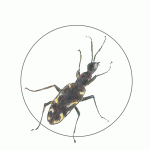 Tiger Beetles Many tiger beetles were once seen prowling the Antioch Dunes, including the wetsalts tiger beetle (Cicindela haemorrhagica), the Oregon tiger beetle (Cicindela oregona), and senile tiger beetle (Cicindela senilis). These tiger beetles are not restricted to the Antioch Dunes, and can be recognized by their bulging eyes and metallic colors. In their larval form, tiger beetles anchor themselves with specialized hooks to tunnels in the sandy soil. When vibrations in the ground announce a passing insect, the larvae lunge from the tunnel and snag their prey with fierce-looking jaws.
Tiger Beetles Many tiger beetles were once seen prowling the Antioch Dunes, including the wetsalts tiger beetle (Cicindela haemorrhagica), the Oregon tiger beetle (Cicindela oregona), and senile tiger beetle (Cicindela senilis). These tiger beetles are not restricted to the Antioch Dunes, and can be recognized by their bulging eyes and metallic colors. In their larval form, tiger beetles anchor themselves with specialized hooks to tunnels in the sandy soil. When vibrations in the ground announce a passing insect, the larvae lunge from the tunnel and snag their prey with fierce-looking jaws.
- Wetsalts tiger beetle (Cicindela haemorrhagica)
- Wetsalts tiger beetle (Cicindela haemorrhagica)
- Wetsalts tiger beetle (Cicindela haemorrhagica)
- Oregon tiger beetle (Cicindela oregona oregona)
- Oregon tiger beetle (Cicindela oregona oregona)
- Oregon tiger beetle (Cicindela oregona oregona)
- Oregon tiger beetle (Cicindela oregona oregona)
- Senile tiger beetle (Cicindela senilis senilis)
- Senile tiger beetle (Cicindela senilis senilis)
- Senile tiger beetle (Cicindela senilis senilis)
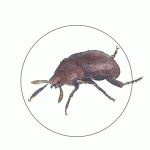 Dune Beetle The San Joaquin dune (darkling) beetle (Coelus gracilis) – the smallest of California’s dune beetles – looks much like a plump, black ladybug with a stubble of golden hairs. Most darkling beetles have black elytra, the hardened wing casings that protect the fragile forewings necessary for flight. Dune beetles inhabit the sandy soils and leaf litter of California’s coastal dunes. The San Joaquin dune beetle has been extirpated from the Antioch Dunes, but has been found in other California sand dunes.
Dune Beetle The San Joaquin dune (darkling) beetle (Coelus gracilis) – the smallest of California’s dune beetles – looks much like a plump, black ladybug with a stubble of golden hairs. Most darkling beetles have black elytra, the hardened wing casings that protect the fragile forewings necessary for flight. Dune beetles inhabit the sandy soils and leaf litter of California’s coastal dunes. The San Joaquin dune beetle has been extirpated from the Antioch Dunes, but has been found in other California sand dunes.
- San Joaquin dune beetle (Coelus gracilis)
- San Joaquin dune beetle (Coelus gracilis)
- San Joaquin dune beetle (Coelus gracilis)
Scarab Beetle Scarab beetles like the Delta june beetle (Polyphylla stellata) can be found in dune systems, oak woodlands, and grasslands near creeks and streams. The Delta june beetle is found elsewhere in California, and appears to have grown increasingly abundant at the Antioch Dunes.
- Delta june beetle (Polyphylla stellata)
- Delta june beetle (Polyphylla stellata)
- Delta june beetle (Polyphylla stellata)
- Delta june beetle (Polyphylla stellata)
- Delta june beetle (Polyphylla stellata)
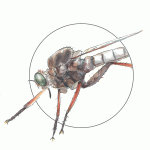 Robberflies California’s robberflies are the peregrine falcons of the insect world, known for tackling their insect prey in midair. Robberflies eat wasps, bees, beetles, flies, quickly stabbing them with their needle-like proboscis. Of the robberflies known from the Antioch Dunes, the widespread Antioch efferian robberfly (Efferia antiochi) and Hurd’s metapogon robberfly (Metapogon hurdi) are still thought to hunt the dunes. The Antioch robber fly (Cophura hurdi) is endemic to the Antioch Dunes, but presumed extinct.
Robberflies California’s robberflies are the peregrine falcons of the insect world, known for tackling their insect prey in midair. Robberflies eat wasps, bees, beetles, flies, quickly stabbing them with their needle-like proboscis. Of the robberflies known from the Antioch Dunes, the widespread Antioch efferian robberfly (Efferia antiochi) and Hurd’s metapogon robberfly (Metapogon hurdi) are still thought to hunt the dunes. The Antioch robber fly (Cophura hurdi) is endemic to the Antioch Dunes, but presumed extinct.
- Antioch efferian robberfly (Efferia antiochi)
- Antioch efferian robberfly (Efferia antiochi)
- Antioch efferian robberfly (Efferia antiochi)
- Hurd’s metapogon robberfly (Metapogon hurdi)
- Hurd’s metapogon robberfly (Metapogon hurdi)
- Hurd’s metapogon robberfly (Metapogon hurdi)
- Hurd’s metapogon robberfly (Metapogon hurdi)
- Hurd’s metapogon robberfly (Metapogon hurdi)
- Antioch robberfly (Cophura hurdi)
- Antioch robberfly (Cophura hurdi)
- Antioch robberfly (Cophura hurdi)
- Antioch robberfly (Cophura hurdi)
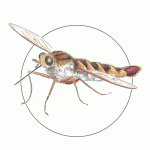 Giant Flower-Loving Fly It is a rare occasion when an animal’s name tells as much about a species as with the giant flower-loving fly (Rhaphiomidas trochilus). Otherwise known as a Valley mydas fly, this large rust-colored fly that visits flowers for their nectar, hovering like a hummingbird. Some Rhaphiomidas flies are suspected of seeking out ant nests to deposit their eggs and provide a food source for their developing larvae. The giant flower-loving fly has been extirpated from the Antioch Dunes, but has been found in other California sand dunes.
Giant Flower-Loving Fly It is a rare occasion when an animal’s name tells as much about a species as with the giant flower-loving fly (Rhaphiomidas trochilus). Otherwise known as a Valley mydas fly, this large rust-colored fly that visits flowers for their nectar, hovering like a hummingbird. Some Rhaphiomidas flies are suspected of seeking out ant nests to deposit their eggs and provide a food source for their developing larvae. The giant flower-loving fly has been extirpated from the Antioch Dunes, but has been found in other California sand dunes.
- Giant flower-loving fly (Raphiomidas trochilus)
- Giant flower-loving fly (Raphiomidas trochilus)
- Giant flower-loving fly (Raphiomidas trochilus)
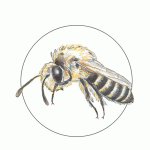 Plasterer Bee Plasterer bees are named for their habit of lining the cell walls of their underground nests with saliva and other materials to create a polyester lining. Some plasterer bees are solitary nesters, others nest in groups. Plasterer bees feed on the nectar of flowers and collect pollen, which they store in their nests for developing larvae. One unnamed plasterer bee (Colletes turgiventris) is endemic to the Antioch Dunes, although it is unknown whether this species is still present today.
Plasterer Bee Plasterer bees are named for their habit of lining the cell walls of their underground nests with saliva and other materials to create a polyester lining. Some plasterer bees are solitary nesters, others nest in groups. Plasterer bees feed on the nectar of flowers and collect pollen, which they store in their nests for developing larvae. One unnamed plasterer bee (Colletes turgiventris) is endemic to the Antioch Dunes, although it is unknown whether this species is still present today.
- unnamed plasterer bee (Colletes turgiventris)
- unnamed plasterer bee (Colletes turgiventris)
- unnamed plasterer bee (Colletes turgiventris)
- unnamed plasterer bee (Colletes turgiventris)
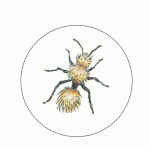 Velvet Ants Despite its name, the velvet ant is a wasp with an ant-like body covered in dense hair like crushed velvet. Females are wingless and can deliver a painful sting. Velvet ants eat nectar, and the females invade the nests of ground nesting wasps and bees to lay their eggs. Their hairy bodies can vary in color from white-to-faint-buttery-yellow (Dasymutilla sackenii) to mahogany red (Dasymutilla flammifera) or interchangeably yellow to red (Dasymutilla coccineohirta). Another velvet ant, the Antioch mutillid wasp (Myrmosula pacifica), searches the soil for scarab or tiger beetle larvae on which they lay their eggs. The larger of these velvet ants (Dasymutilla sackenii and Dasymutilla flammifera) and the Antioch mutillid wasp have been extirpated from the Antioch Dunes, but have been found elsewhere in California; the smaller velvet ants (Dasymutilla coccineohirta) are still present at the Antioch Dunes today.
Velvet Ants Despite its name, the velvet ant is a wasp with an ant-like body covered in dense hair like crushed velvet. Females are wingless and can deliver a painful sting. Velvet ants eat nectar, and the females invade the nests of ground nesting wasps and bees to lay their eggs. Their hairy bodies can vary in color from white-to-faint-buttery-yellow (Dasymutilla sackenii) to mahogany red (Dasymutilla flammifera) or interchangeably yellow to red (Dasymutilla coccineohirta). Another velvet ant, the Antioch mutillid wasp (Myrmosula pacifica), searches the soil for scarab or tiger beetle larvae on which they lay their eggs. The larger of these velvet ants (Dasymutilla sackenii and Dasymutilla flammifera) and the Antioch mutillid wasp have been extirpated from the Antioch Dunes, but have been found elsewhere in California; the smaller velvet ants (Dasymutilla coccineohirta) are still present at the Antioch Dunes today.
- Velvet ant – female (Dasymutilla sackenii)
- Velvet ant – female (Dasymutilla sackenii)
- Velvet ant – female (Dasymutilla sackenii)
- Velvet ant – male (Dasymutilla sackenii)
- Velvet ant – male (Dasymutilla sackenii)
- Velvet ant – male (Dasymutilla sackenii)
- Velvet ant – female (Dasymutilla flammifera)
- Velvet ant – female (Dasymutilla flammifera)
- Velvet ant (Dasymutilla flammifera)
- Velvet ant – male (Dasymutilla flammifera)
- Velvet ant – male (Dasymutilla flammifera)
- Velvet ant (Dasymutilla flammifera)
- Velvet ant – female (Dasymutilla coccineohirta)
- Velvet ant – female (Dasymutilla coccineohirta)
- Velvet ant – female (Dasymutilla coccineohirta)
- Velvet ant – male (Dasymutilla coccineohirta)
- Velvet ant – male (Dasymutilla coccineohirta)
- Velvet ant (Dasymutilla coccineohirta)
- Velvet ant – female (Myrmosula pacifica)
- Velvet ant – female (Myrmosula pacifica)
- Velvet ant – female (Myrmosula pacifica)
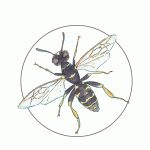 Sphecid Wasps This family of wasps all share in common their narrow, thread-like waists and the practice of stock-piling insect prey as food for their emerging larvae in the cells of underground burrows. The Antioch sphecid wasp (Philanthus nasalis), marked with bands of ivory white and black, hunts mostly bees and wasps, while the redheaded sphecid wasp (Eucerceris ruficeps) collects mostly Dysticheus weevils. After having been stung and paralyzed by these wasps, as many as 20 weevils have been found stockpiled in a single underground cell. Both sphecid species are common to California, although the Antioch sphecid wasp has been extirpated from the Antioch Dunes.
Sphecid Wasps This family of wasps all share in common their narrow, thread-like waists and the practice of stock-piling insect prey as food for their emerging larvae in the cells of underground burrows. The Antioch sphecid wasp (Philanthus nasalis), marked with bands of ivory white and black, hunts mostly bees and wasps, while the redheaded sphecid wasp (Eucerceris ruficeps) collects mostly Dysticheus weevils. After having been stung and paralyzed by these wasps, as many as 20 weevils have been found stockpiled in a single underground cell. Both sphecid species are common to California, although the Antioch sphecid wasp has been extirpated from the Antioch Dunes.
- Antioch sphecid wasp (Philanthus nasalis)
- Antioch sphecid wasp (Philanthus nasalis)
- redheaded sphecid wasp (Eucerceris ruficeps)
- redheaded sphecid wasp (Eucerceris ruficeps)
- redheaded sphecid wasp (Eucerceris ruficeps)
Potter Wasp Potter wasps are named for their habit of constructing mud nests that resemble pots or jugs. Before the nest is complete, the female collects and paralyzes insects and deposits them in the chamber as food for her larva when they hatch. Because the female wasp seals the opening of each nest with a thick plug of mud, the emerging wasp instead makes a hole through the thin wall of the nest chamber to escape. Adult potter wasps are black marked with butter-yellow stripes. Potter wasps are solitary and feed on nectar. The Antioch potter wasp (Microdynerus arenicolus) is found elsewhere in California and is still present at the Antioch Dunes today.
- Antioch potter wasp (Microdynerus arenicolus)
- Antioch potter wasp (Microdynerus arenicolus)
- Antioch potter wasp (Microdynerus arenicolus)
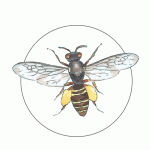 Andrenid Bees The yellow-banded andrenid bee (Perdita hirticeps luteocincta) and the Antioch andrenid bee (Perdita scitula antiochensis) are ground nesters that show a preference for pollen. At the Antioch Dunes, for example, the Antioch andrenid bee collects pollen from the Antioch Dunes buckwheat (Eriogonum nudum psychicola), California matchweed (Gutierrezia californica), telegraphweed (Heterotheca grandiflora), and valley lessingia (Lessingia glandulifera). While both of these andrenid bees are endemic to the Antioch Dunes, only the Antioch andrenid bee survives today; the yellow-banded andrenid bee is presumed extinct.
Andrenid Bees The yellow-banded andrenid bee (Perdita hirticeps luteocincta) and the Antioch andrenid bee (Perdita scitula antiochensis) are ground nesters that show a preference for pollen. At the Antioch Dunes, for example, the Antioch andrenid bee collects pollen from the Antioch Dunes buckwheat (Eriogonum nudum psychicola), California matchweed (Gutierrezia californica), telegraphweed (Heterotheca grandiflora), and valley lessingia (Lessingia glandulifera). While both of these andrenid bees are endemic to the Antioch Dunes, only the Antioch andrenid bee survives today; the yellow-banded andrenid bee is presumed extinct.
- yellow-banded andrenid bee (Perdita hirticeps luteocincta)
- yellow-banded andrenid bee (Perdita hirticeps luteocincta)
- yellow-banded andrenid bee (Perdita hirticeps luteocincta)
- Antioch andrenid bee (Perdita scitula antiochensis)
- Antioch andrenid bee (Perdita scitula antiochensis)
- Antioch andrenid bee (Perdita scitula antiochensis)
- Antioch andrenid bee (Perdita scitula antiochensis)
- Antioch andrenid bee (Perdita scitula antiochensis)
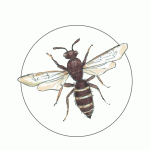 Halictid Bees Because these small bees are often attracted to perspiration, halictid bees are also known as sweat bees. The Antioch Dunes halictid bee (Lasioglossum antiochense) constructs burrows in the sand where it lives by day; the tunnel shaft is plugged by a mound of sand to protect against predators. Eggs are laid in cells off the main tunnel shaft. This bee’s activity matches the early morning/late evening bloom period of its primary hostplant, the Antioch Dunes evening primrose (Oenothera deltoides howellii), and other flowers like the Contra Costa wallflower (Erysimum capitatum angustatum). The Antioch Dunes halictid bee is an Antioch Dunes endemic that still flies today.
Halictid Bees Because these small bees are often attracted to perspiration, halictid bees are also known as sweat bees. The Antioch Dunes halictid bee (Lasioglossum antiochense) constructs burrows in the sand where it lives by day; the tunnel shaft is plugged by a mound of sand to protect against predators. Eggs are laid in cells off the main tunnel shaft. This bee’s activity matches the early morning/late evening bloom period of its primary hostplant, the Antioch Dunes evening primrose (Oenothera deltoides howellii), and other flowers like the Contra Costa wallflower (Erysimum capitatum angustatum). The Antioch Dunes halictid bee is an Antioch Dunes endemic that still flies today.
- Antioch Dunes halictid bee (Lasioglossum antiochense)
- Antioch Dunes halictid bee (Lasioglossum antiochense)
- Antioch Dunes halictid bee (Lasioglossum antiochense)
- Antioch Dunes halictid bee (Lasioglossum antiochense)
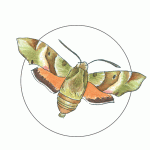 Sphinx Moth Clark’s sphinx moth (Proserpinus clarkiae) is a small moth with a wingspan of under two inches. This moth is active during the daytime, nectaring at the flowers of Clarkias (Clarkia spp.), bluedicks (Dichelostemma capitatum), vetches (Vicia spp.), and thistles (Cirsium spp.) in oak and pine-oak woodlands. Caterpillars feed on Clarkias and primroses (Onagraceae spp.) until winter, when they retreat to burrows under rocks or other objects. Adult coloration consists of striped green-to-grey forewings, and orange-yellow hindwings bordered in black. The Clark’s sphinx moth is a common moth along the Pacific Coast, and can still be found at the Antioch Dunes.
Sphinx Moth Clark’s sphinx moth (Proserpinus clarkiae) is a small moth with a wingspan of under two inches. This moth is active during the daytime, nectaring at the flowers of Clarkias (Clarkia spp.), bluedicks (Dichelostemma capitatum), vetches (Vicia spp.), and thistles (Cirsium spp.) in oak and pine-oak woodlands. Caterpillars feed on Clarkias and primroses (Onagraceae spp.) until winter, when they retreat to burrows under rocks or other objects. Adult coloration consists of striped green-to-grey forewings, and orange-yellow hindwings bordered in black. The Clark’s sphinx moth is a common moth along the Pacific Coast, and can still be found at the Antioch Dunes.
- Clark’s sphinx moth (Proserpinus clarkiae)
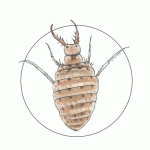 Ant Lion Also known as “doodlebugs,” ant lions are perhaps best known for their behavior in the larval stage, in which the immature insects burrow backwards into sandy soils to lay in wait for passing insect prey, waiting for them to tumble into their sand traps and the ant lion’s formidable jaws. In their adult form, the dragonfly-like ant lions are otherwise weak night-time fliers in the pursuit of insects, pollen, or nectar. The unnamed ant lion (Brachynemurus infuscatus) is common in California and still inhabits the Antioch Dunes today.
Ant Lion Also known as “doodlebugs,” ant lions are perhaps best known for their behavior in the larval stage, in which the immature insects burrow backwards into sandy soils to lay in wait for passing insect prey, waiting for them to tumble into their sand traps and the ant lion’s formidable jaws. In their adult form, the dragonfly-like ant lions are otherwise weak night-time fliers in the pursuit of insects, pollen, or nectar. The unnamed ant lion (Brachynemurus infuscatus) is common in California and still inhabits the Antioch Dunes today.
- unnamed ant lion (Brachynemurus infuscatus)
- unnamed ant lion (Brachynemurus infuscatus)
- unnamed ant lion (Brachynemurus infuscatus)
- unnamed ant lion (Brachynemurus infuscatus)
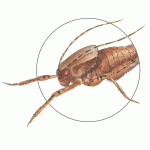 Katydids Of the two katydid species collected at the Antioch Dunes, the Antioch Dunes shield-back katydid (Neduba extincta) is known only from museum specimens and is thought to be extinct. The second species, Middlekauf’s shield-back katydid (Idiostatus middlekauffi), is still thought to exist at the Antioch Dunes and has also been seen near the summit of Mount Diablo. True to their name, shield-back katydids have clunky bodies that look like thick armor. Their diets include flowers and leaves, small insects, and fungi. Male katydids give a “calling song,” a buzz sung from a high perch. Katydids also make a zic zic call to attract mates or when predators approach.
Katydids Of the two katydid species collected at the Antioch Dunes, the Antioch Dunes shield-back katydid (Neduba extincta) is known only from museum specimens and is thought to be extinct. The second species, Middlekauf’s shield-back katydid (Idiostatus middlekauffi), is still thought to exist at the Antioch Dunes and has also been seen near the summit of Mount Diablo. True to their name, shield-back katydids have clunky bodies that look like thick armor. Their diets include flowers and leaves, small insects, and fungi. Male katydids give a “calling song,” a buzz sung from a high perch. Katydids also make a zic zic call to attract mates or when predators approach.
- Antioch Dunes shield-back katydid (Neduba extincta)
- Antioch Dunes shield-back katydid (Neduba extincta)
- Antioch Dunes shield-back katydid (Neduba extincta)
- Antioch Dunes shield-back katydid (Neduba extincta)
- Middlekauf’s shield-back katydid (Idiostatus middlekauffi)
- Middlekauf’s shield-back katydid (Idiostatus middlekauffi)
- Middlekauf’s shield-back katydid (Idiostatus middlekauffi)




